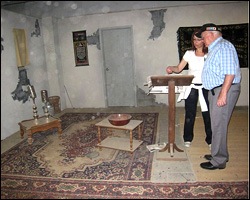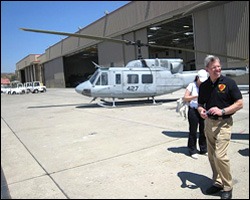Camp Pendleton Visited by JINSA Leaders
JINSA was invited to Camp Pendleton to observe the newest tactics and equipment employed by our Marines. The June visit was hosted by Maj. Gen. Michael Lehnert, Commanding General, Marine Corps Installations West, and escorted by 2008 JINSA Flag and General Officer Trip to Israel alumnus Maj. Gen. Mark Lott, USMC (ret).
JINSA was invited to Camp Pendleton to observe the newest tactics and equipment employed by our Marines. The June visit was hosted by Maj. Gen. Michael Lehnert, Commanding General, Marine Corps Installations West, and escorted by 2008 JINSA Flag and General Officer Trip to Israel alumnus Maj. Gen. Mark Lott, USMC (ret).
The visit began the evening of the 18th with a dinner hosted by JINSA attended by General Lehnert, General Lott, and senior officers from Gen. Lehnert’s command plus spouses. This was a great opportunity for our group to socialize with the Marines and to familiarize them with JINSA.

Early the next morning, we attended the first briefing of the day on the Infantry Immersion Trainer system. Installed in late 2007, this brand new simulator creates a realistic battle environment inside of a 32,000-square-foot former tomato-packing warehouse located near Camp Pendleton’s San Mateo northern infantry camp.
The trainer uses real people and full movie-set-quality interior and building mock-ups: role-playing civilian villagers and insurgent fighters as well as furnishings, doors and stairwells. Those are combined with sophisticated electronic avatars appearing on dozens of flat panel video screens and projected onto walls (technology borrowed from video games and the motion picture industry) that show, for example, ever-changing details of a room’s interior or an enemy combatant. Those are combined with virtual effects – explosions, sounds and smoke. Taken in total, a “real” Iraqi village (complete with souk, cars, alleys and homes) is recreated. The realism extends as far as spritzing “camel dung” odor into the air so that sights and smells are the real deal.
The trainer’s purpose is to provide the most realistic combat conditions and settings to the small unit in order to teach and reinforce combat decision-making and small unit mission rehearsal. All are tied into a constructive play that can be tailored toward particular missions, roles and environments.
A Marine squad can run through up to four different scenarios per day in the Infantry Immersion Trainer. Members of a fire team or squad will dismount and patrol with their standard weapons and communications and combat gear, searching shops, homes and other buildings. Rooms and buildings will be tailored and fashioned to a specific combined-arms operating or combat environment. And the scenarios are quite realistic.

Members of the JINSA delegation were able to be “statues” during an actual training exercise, part of the scenario but not directly engaging with the Marines. The Marines use regular M-16 rifles with modified barrels that shoot a “paint ball-type” projectile. It won’t kill, but it leaves a heck of a bruise. As they patrol the souk, they may be approached by a woman offering a basket of fruit or flowers. Sometimes, the basket explodes; it was a concealed IED. Snipers, casualties, yelling, confusion. Just like the real thing. Statistically, 80 percent of Marine casualties occur in the first 30 days of deployment. The goal of this training is to make their first battle no tougher than their last simulation. And it’s working.
The transit to the main base for lunch with a Marine squad took about 25 minutes since Camp Pendleton covers 200,000 acres and is home to 43,000 Marines and some 100,000 other people including dependent families and civilian contractors. This is always a great opportunity for us to speak with the enlisted men and women, to hear their stories and, in some cases, listen to their gripes. It’s also a chance for Marines to learn about JINSA, and to know that we’re out there supporting their mission. Every once in a while, when you read something in the paper or hear it on the news, JINSA had a hand in making it happen. We left lunch inspired by the patriotism, dedication and professionalism of our U.S. Marines.
Next stop was the interactive small arms simulator that uses real weapons modified to “shoot” light pulses. Targets appear on a large wall-sized video projection. This simulator allows Marines to practice judgment and accuracy when forced to return fire at enemy combatants attempting to use civilians as shields.

Next, we visited the “Atlas Squadron” also known as Marine Light Attack Training Squadron 303 (HMLAT-303). HMT-303 trains newly commissioned Naval Aviators, conversion pilots, refresher pilots, and enlisted aircrew on the AH-1W SuperCobra and the UH-1N Twin Huey. HMLAT-303 is also to begin training with the new UH-1Y Venom and AH-1Z helicopters. It is part of Marine Aircraft Group 39 (MAG-39) and the 3rd Marine Aircraft Wing (3rd MAW). On display were examples of these newest of Marines helicopters: the AH-1Z “Viper” gunship and the UH-1Y “Venom” medium transport. Highly modified versions of their antecedents, which date to the Vietnam War, the Viper and Venom each have bigger engines, new rotors, state-of-the-art electronics and highly motivated crews. These Marine aviators were professional, knowledgeable and eager to show off their new charges.
Our last stop was the commandant’s residence. Camp Pendleton has a long history dating back to the 1800s and was an operating ranch for most of that time. The original “casa” has been home to the commanding general since Camp Pendleton was established in 1943. General Lehnert decided several months ago to move out and turn the home into a museum of California history.